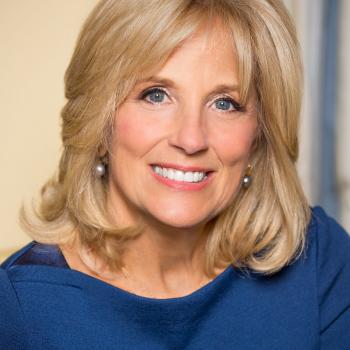One interesting thing about feed readers is the order you sometimes find yourself reading pieces. Take this morning, for instance.
First I read an article titled Everybody in dresses: Why does gender neutral clothing always mean ‘boy’ clothes for girls? by Audra Williams. Williams discusses a commercial for a new line of clothes Ellen Degeneres created for GAP Kids. According to GAP, the line is “more than just a clothing collection. It is a social movement meant to empower young girls to be their own heroes.”
Take a look at the commercial:
https://www.youtube.com/watch?v=zIT1XyD_pPQAs Williams notes:
Is it really that revolutionary for girls to wear pants and muted colours, no matter what the soundtrack? Why does “gender neutral” have to mean “without any traditionally feminine signifiers”?
Because girl clothes are for girls. Boy clothes are for everyone.
. . .
I don’t want to downplay the merits of this clothing line, or the importance of advocating for little girls who were so stoked to take their Spiderman backpacks to school this week, only to come home in tears because “Spiderman is for boys.” Not every girl feels like herself when wearing ruffled dresses or head-to-toe pink and purple, and I’m really glad those girls have some other fun choices now. . . .
But the same gender-role-wiggle-room is not available to their brothers. Where is Adam Lambert’s line for Gap Kids, promoted with an upbeat commercial of young boys playing with dolls and doing ballet while wearing shiny sparkly glam clothes and lipgloss while Diamond Rings serenades us all?
If The Gap did this, I think everybody would have what my late Nan would call “a complete conniption fit.”
As Williams so aptly points out:
As long as ‘feminine’ is treated as a synonym for ‘weak,’ girls are going to continue to be underestimated and boys are going to continue to be bullied when they step out of the gender box they’ve been put in.
Williams’ words reminded me of another article I’d read recently—Papas, please let your babies grow up to be princesses. In that article, the author, Sara Chipps, creator of Jewelbots, wrote about objections that her product’s combination of jewelry and programming was too girly.
The whole idea behind getting more women into programming is to introduce diversity. The reason why diverse teams create better products is the different backgrounds and experiences they bring to the table.
Bringing diversity to science and technology doesn’t mean that we socialize everyone as a white or asian male. We shouldn’t try to shoe-horn girls in to our own concepts of what the childhood of a scientist looks like.
By saying “forgo girly things for things that will get you interested in engineering” we’re saying “if you want to be girly, you cannot also be a technology creator, an inventor, and a world changer”. We’re teaching girls to change who they are in order to effect change as an adult.
Anyway, my feed reader took me straight from Williams’ article, with its objection to devaluing the feminine and presenting gender neutral as the empowering option, to Nathan Lents’ Science is for Boys and Makeup is for Girls, a critique of the following advertisement for chemistry sets:
As Lents explained:
It doesn’t take a degree in gender studies to see the subtext here. Makeup is for girls and real science is for boys.
. . .
The “hook” for the boy set is that it is “guaranteed to fascinate young scientists,” while the girl kit is sold with, “Chemistry might be the most beautiful branch of science.” Boys get to “use real lab equipment.” Girls get to “draw big smiles.”
We get it. Boys are serious. Girls are pretty.
This is exactly the kind of pernicious sexism that drills into our children’s head that ‘science is for men.’ Images like these have profound and lasting impacts on children as they develop their sense of self-efficacy. This plants a seed in little girls (and little boys) that will germinate, grow, and rear its ugly head years later, especially as school gets tougher and choices have to be made.
At first, reading this article, I was completely sold. And then I paused. Williams’ article decried the idea that the way to empower girls is to push them toward gender neutral options and away from “girly” things, and Chipps pointed out that we shouldn’t feel the need to socialize girls as white males to interest them in the sciences. Both authors called attention to the problems inherent to portraying the feminine as less than. And yet Lents is arguing that having “girly” science options is a problem.
What’s going on here, exactly?
To dispense with the obvious, Lents’ critique is very similar to my critique of Lego Friends several years back—if girls aren’t going into a career field or playing with a toy line, the solution has got to be more holistic than simply tacking on a “for girls” option that plays on stereotypes. We have got to see girls more holistically and stop reducing them to an interest in makeup and all things pretty.
You know, like this:
People, don’t do that. Please, just don’t.
Okay, back to the chemistry sets. The real problem with the chemistry sets in that ad is that the makeup sets are consciously marketed toward girls while the regular sets are consciously marketed toward boys. As Lents noted, this risk communicating that girls are pretty while boys are serious. But the fix to this problem is not to get rid of the makeup kits. That would communicate what Williams and Chipps pointed out—that things that are coded feminine are somehow less than, and that equality means girls acting like boys.
A more holistic fix would be to have a boy and a girl on the front of each of those sets—or no children at all—and to redesign the coloring and decoration on the boxes so that the one set doesn’t shout “for girls!” while the other shouts “for boys!” We do need science kits for making makeup—and lego cafe and pet shop kits—but we need to stop using advertising to segregate girls into those options while reserving the main options for boys.
There’s another side to this, too. Remember Williams’ point that while society accepts girls who wear pants, it doesn’t accept boys who wear dresses? When we segregate the girls’ options we keep boys from trying those things too and communicate to them that “girl” things are things to be avoided—and that the feminine is somehow less than or beneath them. If we focus instead on having a range of options that reflect the breadth of all children’s interests, and avoid packaging them in a way that labels them “for boys” or “for girls,” we can encourage all children to express themselves authentically without pushing them into gender-labeled options.
Of course, even this doesn’t tell us what to do with products like this:
Can gendered advertising be done in a way that values the feminine without contributing to stereotypes about girls? If we say “no” and avoid gendered advertising altogether, does that suggest equality simply means eliminating the “girl” option in leu of everyone using the ostensibly “neutral” but actually “boy” option? Will having “girl” options always promote this sort of stereotyping and segregation? And what about Chipps’ Jewelbots, programmable friendship bracelets marketed to girls?
https://www.youtube.com/watch?v=xr-8tYfIzsUI may have come to the end of the post, but I haven’t found the answers I was hoping I would while writing my thoughts out. And I suppose that’s fine. Sometimes having questions to ponder is more important than having answers. How can we value the feminine without pushing girls into gendered tracks? Where is the line between catering to girls’ interests and feeding stereotypes? How can we encourage women to enter tech without either typing them as “other” and “different” or requiring them to give up everything coded feminine?















